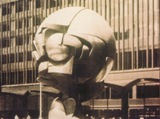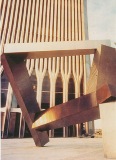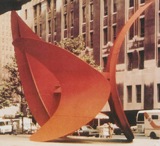International Foundation For Art Research (IFAR) www.ifar.org
This article may not be published or printed elsewhere without the express permission of IFAR
September 11th:
ART LOSS, DAMAGE, AND REPERCUSSIONS
Proceedings of an IFAR Symposium on February 28, 2002
Public Art at the World Trade Center, page 2
by Saul Wenegrat
The centerpiece of the World Trade Center Plaza was a colossal fountain designed by Fritz Koenig of Germany. The sphere of the fountain (Fig. 3) was a globe-like structure, 25 feet high. Made of bronze, it stood on a black granite base out of which flowed sheets of water. Through its shape, the piece was intended to symbolize world peace through world trade, which was the theme of the World Trade Center.
Between the two Trade Center towers, there was a large, stainless steel piece called Ideogram by a New York sculptor, James Rosati (Fig. 4). Completed in 1974, this twenty-five-foot piece was one of the more interesting commissions on the plaza, because as you moved around it, it took a different shape. It was also one of the most photographed pieces there, since people in the fashion industry seemed to like it and incorporated it into a lot of fashion ads.
Alexander Calder's WTC Stabile (Fig. 5), also known by other names like The Cockeyed Propeller and Three Wings, arrived in 1971. It was 25 feet in height and was made out of painted red steel. The piece was originally commissioned for the entrance to 1 World Trade Center on West Street. After Battery Park City was opened, the piece was moved to Vesey and Church Streets where it is seen in this photograph. At the time of the recent disaster, it was located on a plaza in front of 7 World Trade Center.
The World Trade Center Tapestry of Joan Miró (Fig. 6) arrived in 1974. It was not really a commissioned piece. I had spoken with Miró about the possibility of doing a tapestry, and he had turned me down, saying: "When you do a tapestry, you really don't do it yourself, and I don't make any art where I don't use my two hands." Then he had a tragedy in his family. His daughter was traveling in Spain and was involved in an accident. She was taken to a hospital. Miró told the nuns who ran the hospital that, "Hopefully my daughter will recover, and if she does, I'll give you any art work that you would like." His daughter did recover, and the nuns asked for a tapestry. He said he didn't do any tapestries. They said, "We have somebody in our village who does tapestries. He'll teach you." So, Miró worked with this tapestry maker in their village, and he got to like it. He decided to practice, and he made about 20 little tapestries, some of which were shown in New York. Then I got a communication from his dealer in Paris saying, "Your World Trade Center tapestry is done." I said, "What?!" He said, "It's in the Grand Palais [in Paris] in Miró's retrospective, and it's yours if you want it, but he made it especially for the World Trade Center."
The tapestry was made out of wool and hemp and was large—20 feet by 35 feet. It was a unique piece, and after he finished it, Miró said, "It's too much work making tapestries. I'm not going to make any more." But then he got a call from the The National Gallery of Art in Washington, which had seen the World Trade Center Tapestry and wanted one for its new East Wing. So Miró did one more, and that was the last tapestry that he did. Ours hung in the lobby of 2 World Trade Center. You would have seen it on the way to the observation deck.
Continue to page 3



